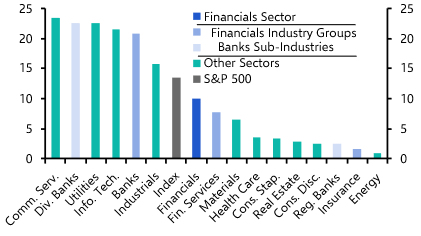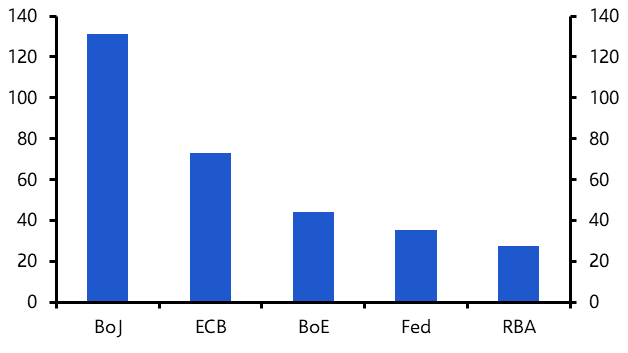Last week we published our latest Global Inflation Watch. It argued that a strong recovery in global GDP growth this year would be accompanied by a sizeable rebound in global inflation. One of the key drivers of the impending rise in inflation is the sharp increase in global commodity prices over the past year. The S&P GSCI index of commodity prices has more than doubled from the lows reached in April last year.
Commodity prices are volatile and their effect on inflation tends to be short-lived. This is why economists often look at “core” inflation, which strips out energy and food items, to get a better sense of underlying price pressures in an economy. But many forecasters are now predicting a new “supercycle” for commodities, in which prices are driven ever higher over many years. If this were to happen, the upward effect on inflation could be longer-lasting. How seriously should we take these warnings?
First, it helps to be clear about what we mean by a “supercycle”. Broadly speaking, it can be thought of as a period in which prices rise continuously over several years – before experiencing a similarly prolonged decline. This happens because demand for commodities can be subject to large and sudden shifts – for example, caused by the rapid development of major economies – but supply is often slow to respond. Mining and drilling capacity cannot be increased quickly or cheaply. It requires large and expensive investment stretching over long time horizons.
The result is that a structural increase in demand for commodities can result in a significant rise in prices that is sustained over many years. This creates the upswing of the supercycle. Eventually, however, supply catches up and higher prices start to choke off demand, which then causes them to drop back. This creates the downswing in the cycle. All of this plays out over several decades.
Our Commodities team has identified three textbook supercycles over the past 130 years. (See Chart 1.) The first began in the late-19th century and was driven by US industrialisation. The second started after World War Two and was underpinned by reconstruction in Europe and Japan. And the third got underway in the 1990s and was rooted in China’s rapid industrialisation and integration into the global trading system. There is a case for including a fourth supercycle in the 1970s but, as our team points out, this was triggered by cuts in OPEC oil supply rather than a surge in demand for commodities. It was therefore a policy-induced spike in prices, and thus very different in nature to the three other cycles.
Chart 1: Difference Between Real Commodity Prices & Long-Run Trend

One thing that all these episodes had in common is that they were framed by a simple narrative that explained the initial rise in prices and built expectations of further increases in the future. This helps to sustain the initial upswing of the cycle.
The narrative of a new supercycle is built around the green economy. This may sound odd. After all, “greening” the global economy should make it less commodity-intensive. Yet achieving this requires substantial investment in new green infrastructure, which itself is commodity intensive. Electric vehicles use three times more copper per unit than their conventional (fossil-fuelled) counterparts. The immediate effect of a surge in green investment would therefore be to boost demand for a whole range of commodities, thus setting the stage for a new supercycle.
In reality, however, we suspect the drivers of commodity prices over the next couple of years will be more mundane. China remains the dominant player in industrial metals. It accounts for roughly half of the global consumption of most industrial metals. Unsurprisingly, there is a strong correlation between our proprietary measure of economic growth in China and shifts in industrial metals prices. (See Chart 2.) As I argued last week, we expect China’s economy to slow over the next year as pre-pandemic problems resurface. And we expect the price of most industrial metals to fall with it.
Chart 2: CE China Activity Proxy & Industrial Metals

In other markets, oil demand is likely to surge over Q2 and Q3 this year as economies re-open and travel within (if not between) countries recovers. Our oil team expects this to lead to a jump in prices over the coming months, with Brent crude topping $80pb by the middle of the year.
But higher prices are likely to induce a supply response. As things stand, OPEC+ is currently keeping about 10% of global oil supply off the market. This can be justified by the fact that oil demand is currently around 10% below its pre-virus level. But the cuts become more difficult to justify if demand rebounds. The current caution about the future state of demand is likely to wane over the second half of the year as global growth surges – and with it the consensus in OPEC+ over the need to continue rolling over production cuts is likely to fray. We expect oil output to rebound in 2022, which in turn should weigh on prices. We don’t expect a collapse, but we do think Brent crude will be trading around $70pb by the start of 2022 and $60pb by the end of the year.
If we are right, this would have echoes of the shift in prices following the global financial crisis in 2008-09, in which an initial rebound gave way to renewed weakness a few years later. Viewed this way, what we are currently witnessing is not so much the start of a supercycle as a normal cyclical recovery.
There are good reasons to expect inflation pressures to build in some (though not all) advanced economies over the coming years. But these relate to an institutional shift on the part of central banks. Despite recent price movements, the likelihood of a sustained increase in inflation being caused by the onset of a new supercycle in commodities seems low.
In case you missed it:
- Our Senior China Economist, Julian Evans-Pritchard, argues that Beijing is quietly doubling-down on “Made in China 2025”.
- Our Chief Markets Economist, John Higgins, explains why the America’s stock market is unlikely to keep beating its economy.
- Our Senior EM Economist, Jason Tuvey, responds to the shock sacking of the governor of Turkey’s central bank and explains why the economy is more vulnerable to a currency crisis than in the recent past.



